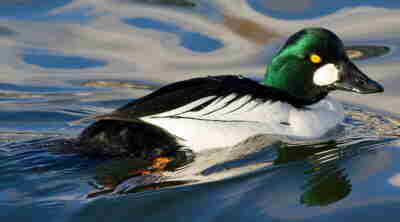| Common
Goldeneye Bucephala
clangula
Description
The common goldeneye is
distinguished from other goldeneyes by its puffy
head shape and a large white wing patch that is
conspicuous in flight. And, in flight, its wings
produce a characteristic whistling sound. Males
have a white body, black back, and iridescent
green head, while females are mostly gray and
have a dark brown head. Both sexes have a
prominent white, oval-shaped patch at the base of
the bill.
A medium-sized diving duck, the
common goldeneye is 16-20 inches long, has a
wingpsan of about 30 inches, and weighs up to two
pounds.

Distribution and
Habitat
Common goldeneyes are found
throughout North America and Eurasia, along
coastal waters and inland rivers and lakes. They
breed farther north than any other duck, from
Scotland through northern Europe to the Kamchatka
Peninsula, across Canada, and from northern
Minnesota to Maine. Often the last ducks to
migrate, some populations may stay in their
breeding range year round if their preferred
habitats stay ice-free.
Reproduction
Breeding season runs from
December through May. During his courtship
display the drake stretches his head
forward along the water and then snaps it rapidly
upward over his back, bill pointed skyward, while
uttering a shrill, two-noted call. Then he swings
his orange feet forward, sending up a small
shower in front of him. Several males may perform
displays to one or two females at a time, but
each female will only choose one mate per year.
The hen lays 6-15 pale green
eggs in an abandoned woodpecker nest, tree
cavity, or nest box, lined with down. She will
incubate the eggs alone for 27-32 days, leaving
them unguarded when she goes for food. Chicks can
leave the nest within 24 hours after hatching,
but will be guarded and brooded by the female for
up to 6 weeks; they can fly at 8-9 weeks. Males
take no part in caring for chicks.
Diet
Common goldeneyes feed on
aquatic insects and plants, small fish, mollusks,
and crustaceans; some seeds and tubers are also
taken. They usually forage in open water and dive
to catch prey.
Scientific
Classification
phylum Chordata
subphylum Vertebrata
class Aves
order Anseriformes
family Anatidae
subfamily Anatinae
genus & species Bucephala clangula
Questions or comments about
this page?
|



